https://mil.news.sina.com.cn/china/2020-06-04/doc-iirczymk5138896.shtml
中国超燃冲压技术获突破 已遥遥领先美国
中国超燃冲压技术获突破 已遥遥领先美国
7,699
5月30日,美国SpaceX公司成功发射了载人的“龙”飞船。在航天飞机停飞9年后,美国终于再次拥有了载人空间发射的能力。这不仅圆了马斯克的梦,也给身陷囹圄的特朗普解了5分钟的套。但是在太平洋的另一端,中国科学院力学研究所悄悄地发表了一条消息,范学军团队在超燃冲压发动机地面试验中实现了连续600秒的运行时间,打破了美国X-51研究机210秒的世界记录。2016年,印度宣布实现了超燃冲压推动的M6高超音速飞行,但发动机只工作了5秒钟。不久前,科技部公布的第二节全国创新争先奖名单里,北航的高超音速强预冷团队获奖,也引起了人们的极大关注。这两样突破性技术的意义非同小可。
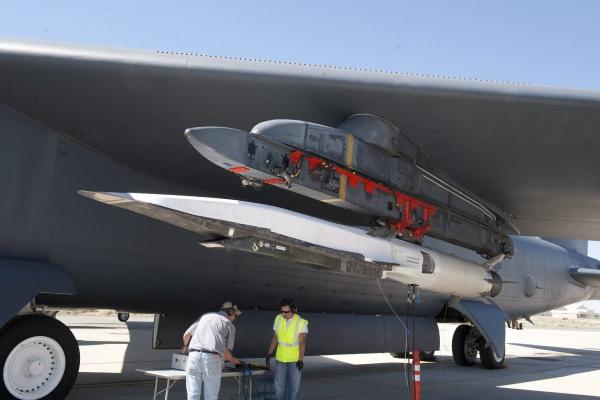 2013年美国X-51A“乘波者”创造了以M5的速度连续工作210秒的世界记录
2013年美国X-51A“乘波者”创造了以M5的速度连续工作210秒的世界记录
高超音速是航空航天科技的最前沿。这也是介于大气层内的航空和大气层外的航天之间的灰色但多彩的区域。大气层内的航空科技难以突破M3的热障,大气层外的航天科技难以解决高机动飞行问题,介于两者之间的高超音速飞行不仅可以M5-20的超高速飞行,还具有可观的机动能力。
在2019年国庆70周年大庆的时候,中国高调展示了东风17高超音速导弹,这代表了当前高超音速的最高水平,但这还是高超音速滑翔弹(简称HGV)。换句话说,导弹用火箭发动机推进到近地高度后,改变姿态,转入高超音速滑翔。与弹道导弹相比,HGV的飞行高度低,由于地球曲率的缘故,地面雷达的探测距离远远低于弹道导弹,预警机的巡航高度也不能根本解决问题。在轨道上的天基探测在理论上没有视界局限,但传统导弹预警是根据导弹发射时的巨大尾焰和初始轨迹来推断弹道的,HGV在发射时依然有尾焰问题,但转入滑翔后,可以通过机动能力完全摆脱简单弹道,使得导弹的航迹无法预测。在探测到发射后立刻用星载雷达全程跟踪在理论上是可能的,但中轨道卫星跟踪需要巨大的星载雷达,低轨道卫星则需要密集星群和“动对动”无间隙接力跟踪。红外光电跟踪不仅有类似的光学孔径问题,还要面对复杂的地球表面热环境中检测微弱的HGV热特征的问题。在可预见的将来,天基探测还有难以克服的技术困难。没有有效的跟踪,就谈不上有效的拦截,所以HGV的突防能力比速度更快但弹道呆板的弹道导弹更高。
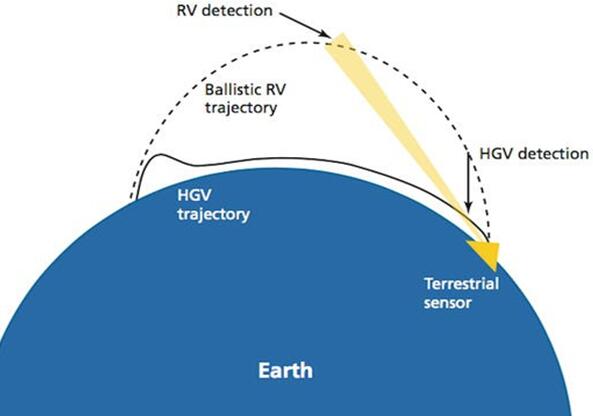 弹道导弹(RV)与高超音速滑翔导弹(HGV)的探测距离比较
弹道导弹(RV)与高超音速滑翔导弹(HGV)的探测距离比较
正因为如此,HGV成为各国军事科研的重点。中国不仅有东风17,还有东风26,也具有高超音速滑翔的能力。俄罗斯的“先锋”是洲际HGV,达到M27的极高速。美国落后了,在一大堆令人眼花缭乱的快车道研发计划之后,现在总算开始有点头绪了。但HGV的射程取决于助推段达到的高度或者大气层内的改平加速,前者增加了扎猛子返回到水平起滑的平滑过渡的难度,后者是把本质弹道的助推段强拧变轨了,损失能量。比HGV更高层次的是高超音速巡航导弹。
巡航导弹是一个容易引起歧义的称呼,这其实是对所有在射程内绝大部分距离上都是有动力飞行的导弹的总称,掠地飞行的高亚音速巡航导弹只是巡航导弹的一种。大部分战术导弹不称为巡航导弹是因为火箭发动机只工作很短时间,射程内主要部份都在滑翔飞行。这不仅对弹道导弹如此,空空导弹、空地导弹甚至反坦克导弹也如此。常见导弹中只有反舰导弹、陆攻巡航导弹是全程有动力飞行的。高超音速导弹采用超燃冲压发动机后,也是全程有动力飞行,所以称为高超音速巡航导弹(简称HCM)。
与HGV相比,HCM的射程更大,弹道更难探测。HGV的能量全部来自于助推级的火箭发动机。自带氧化剂的火箭发动机在重量上比可以从空气中吸取氧气的喷气发动机总是吃亏的。以煤油-液氧火箭为例,理想燃烧的空燃比为15:1。也就是说,每一公斤航空煤油需要15公斤氧气才能完全燃烧。用液氧可以节约体积,但重量还是一样的。如果氧气可以来自空气,在理论上,这15公斤的液氧重量就全部可以转用于煤油,射程的增加不言而喻。
喷气发动机更长的工作时间也意味着可以有更长的加速时间,可以用较低的初始能量达到同样的最高速度,并在最高速度上维持更长的时间。喷气发动机更大的能量也意味着容许更大的机动性,因为机动是要消耗能量的。与HGV只能做相对简单的横向机动不同,HCM可以做更加复杂的机动,甚至迂回攻击。
HCM的助推器只要加速到超燃冲压的点火速度就可以了,因此对助推器的要求大大降低,有助于降低助推器的体积和重量。较小的助推器意味着较小的发射时热特征,而超燃冲压本身的热特征远远小于火箭发动机,这意味着HCM实际上不可能由天基探测捕获,进一步提高抗早期预警的能力。高超音速导弹本来就拦截困难,无预警拦截就几乎不可能了。如果说HGV还有可能知道大祸即将临头,HCM就是死都不知道怎么死的了。
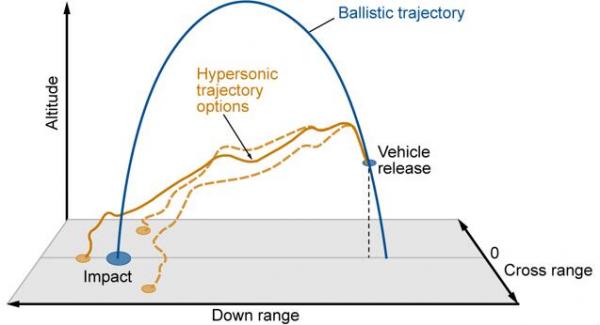 与弹道导弹相比, HGV的弹道要飘忽得多
与弹道导弹相比, HGV的弹道要飘忽得多
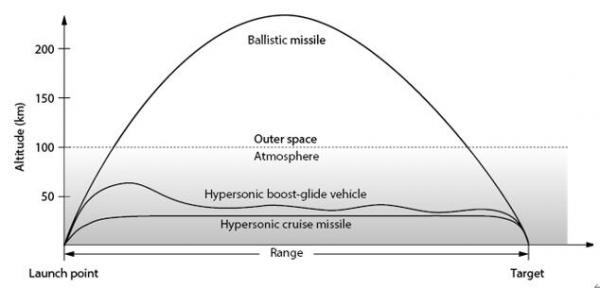 但HCM的弹道更加低平,更难探测,也可达到更高的射程和机动性
但HCM的弹道更加低平,更难探测,也可达到更高的射程和机动性
HCM是终极高超音速武器。美国曾经想一步到位,直接发展HCM,但卡在动力问题上。X-51虽然达到210秒,但这是高度优化的实验条件,而且工作时间太短,离实用化还有巨大的距离。在美国“先放一放”的时候,中国悄悄赶上来了,而且一下子在两个关键技术上取得突破。
在各种已知的航空动力中,火箭发动机的工作时间太短,常规涡轮类喷气发动机难以突破M2.5以上的速度,常规的亚燃冲压也很难突破M4,因为阻力的增加已经快于推力的增加了。只有超燃冲压能用于HCM。这也是冲压发动机,属于喷气发动机,但没有常规涡轮类喷气发动机的涡轮机械。超燃冲压在外观上就是一截空心筒子,但这空心筒子大有讲究。
与亚燃冲压相比,超燃冲压的进气压缩、燃烧和形成推力都是在超音速条件下进行的。与亚燃冲压需要把进气降低到亚音速、然后把燃气加速到超音速相比,大大降低了阻力。但在超音速条件下,不仅燃烧难以稳定,还有高温问题,很容易超过结构材料的耐温极限。范学军团队的主要贡献在于热端部件主动冷却技术。
以燃烧为原动力的发动机通常都有某种冷却。汽车发动机基本上采用液冷,循环的冷却液从发动机带走热量,然后把热量通过散热器向空气中散发;喷气发动机主要依靠空气流动和燃气喷出带走热量。但主动冷却在发动机热端部件(对超燃冲压来说,就是燃烧室和喷嘴)表面下遍布毛细管,通入碳氢燃料,在流动中带走热量,降低表面温度。碳氢燃料吸热升温后,实际温度超过点燃温度,但由于无氧环境而只是升温,并不燃烧。但碳氢燃料注入燃烧室的时候,一方面自然地降压气化,另一方面与进气中的氧混合并自然燃烧,比通常的点燃更加高效可靠。
碳氢燃料是燃油的高级形式,进一步的话可容易地转变为液氢,吸热和燃烧效率更高。但液氢的制备和储存比碳氢燃料要复杂,常温常压下的稳定性也不如碳氢燃料。范学军团队用的是成本更低、稳定性更好的碳氢燃料。
主动冷却的道理不复杂,优点也明显,但恶魔就在细节之中。碳氢燃料在毛细管里的流动需要考虑淤塞问题。毛细管的分布更是有大讲究,过于细密没有必要,过于粗疏则达不到目的。更大的问题是,在流动网络里,优势流动(preferential flow)使得流动的分布偏离预想的均匀,一束看起来差不多的管路里,路径“顺”的流量可能高于需求,路径“不顺”的则可能流量不足,必须通过精细的管径、弯头设计来平衡流量分布,确保均匀吸热。路径之间中途互联可以在部份路径淤塞的时候,用绕流弥补,但使得优势流动的问题进一步复杂化。毛细管内的流动还需要避免流体加热气化后导致气阻的问题。
范学军团队不仅解决了大量理论和设计问题,还在怀柔建造了大型测试装置,解决了工程问题,使得研究成果达到很高的技术成熟程度。
根据力学所的介绍,范学军在普林斯顿获得博士后,成为力学所研究员、博导,担任某部委运载技术专业组专家、国家重大专项燃料组专家与某重大专题技术首席。他在国内率先开展主动冷却发动机技术研究,在力学所怀柔基地建成首套主动冷却技术综合试验平台,技术上处于国际领先水平。他领导研制成功了我国首台主动冷却燃烧室并通过长时间试验考核。近年来,共发表国内外杂志论文50多篇、会议论文与国防技术报告100多篇,发明专利申请30多项、已授权近20项。2006年,荣获国防科技二等奖;领导的技术研究团队荣获了国家重大专项2011年度优秀研究团队奖,个人获得2013年度先进个人二等奖;同时获得首届“冲压发动机及其组合循环发动机科学研究兴舟奖”;2016年获得国务院“政府特殊津贴”;2017年被聘为中科院特聘研究员。但这不是中国高超音速科研大军里唯一的尖子队,北航的高超音速强预冷团队是另一个。
主动冷却技术提高发动机热端部件的耐热能力,进气强预冷可以进一步提高。不久前,英国的SABRE发动机实现了强预冷,可在0.01秒内将1000度的进气冷却到零下150度。这是很了不起的成就。北航团队的具体技术和应用没有公布,但也是同样性质的。
强预冷不仅大幅度提高发动机热端部件的耐高温极限,还急剧缩小了进气体积,提高了进气密度。这使得在同样的进气口体积流量下,压气机的体积流量大幅度降低;或者在同样的压气机体积流量下,大幅度提高气流中的氧含量。前者可以等效为提高了进气口流速的上限,使得同样的发动机技术可以在更高的速度下工作;后者对空气稀薄的极高空特别重要,可以使得喷气发动机可以在更高的高空稳定工作,降低空气摩擦阻力,否则就需要使用重量大、成本高、工作时间短的火箭发动机了。SABRE正是这样的。
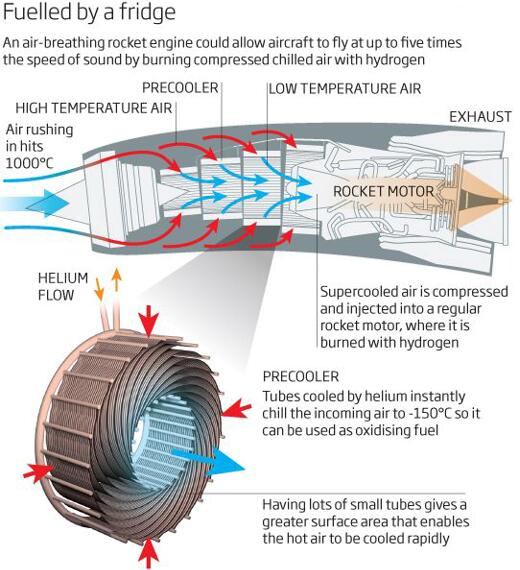 SABRE的工作原理,像层层盘起来的蚊香一样的预冷器是关键技术。橙色=冷却剂的流动方向,红色=空气进气方向,蓝色=空气出气方向
SABRE的工作原理,像层层盘起来的蚊香一样的预冷器是关键技术。橙色=冷却剂的流动方向,红色=空气进气方向,蓝色=空气出气方向
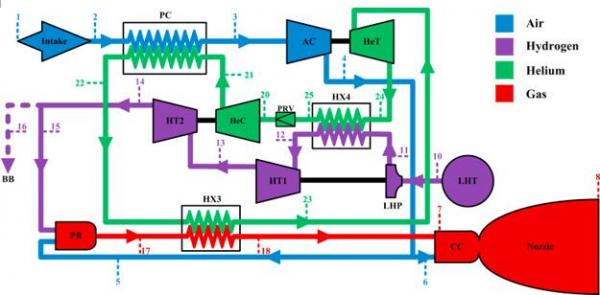 SABRE热力学循环简图,蓝色=空气路线,紫色= 氢路线,绿色=氦回路,红色=燃气路线
SABRE热力学循环简图,蓝色=空气路线,紫色= 氢路线,绿色=氦回路,红色=燃气路线
SABRE的全称是Synergetic Air Breathing Rocket Engine,大意为伴生吸气火箭发动机。这是一种用于水平起飞、单级入轨航天飞机的新概念混合动力发动机,用强预冷使得从空气中吸取氧的工作状态可以一直维持到M5和超高空,然后转入火箭动力,进入空间飞行。
具体来说,进气在预冷器(PC)里强预冷后,通过压气机(AC)达到高压,一部分进入燃烧室(CC),与预燃后炽热的贫氧富氢燃气混合燃烧,通过喷嘴(Nozzle)产生推力;大部分空气进入预燃室(PB),与氢气混合燃烧后,加热氦气。氦气受热膨胀后,推动氦气涡轮(HeT)驱动压气机。做功降温后但依然有很高温度的氦气通过换热器(HX4)使得液氢受热气化,形成高压,推动氢气涡轮(HT1)驱动液氢泵(LHP)从液氢储罐(LHT)里抽取液氢。降压后的氢气还有足够压力,继续推动另一台氢气涡轮(HT2),驱动氦气制冷压缩机(HeC),用于预冷器,就像电冰箱里的氟利昂压缩机提供制冷剂一样。事实上,氦在这里就相当于氟利昂。
SABRE的热力学循环相当复杂,但也很精巧。SABRE的设计原意不是用于超燃冲压的,使用吸气火箭发动机正好回避了超燃冲压的难题,大气层内的高超音速飞行也只是过渡阶段,只是为大气层外的火箭动力飞行提供尽可能高的起始速度和高度。但是适当简化后,SABRE的思路也可以用于超燃冲压。比如说,取消氦回路,燃料泵出来的燃料直接进入预冷器和热端冷却系统,加热气化产生高压,推动的涡轮直接驱动燃料泵。这样,连预燃室都可以取消了。
主动冷却和强预冷都属于超燃冲压发动机的热管理技术。人们经常关注于超燃冲压的燃烧稳定性问题,这确实是巨大的技术挑战,就像可控爆炸一样艰难,但热管理是同样巨大的难题。中国在2017年里程碑式的厦门国际会议上,就暗示了超燃冲压技术已经达到相当高的技术成熟程度。现在热管理技术也达到了很高的技术成熟程度,没有公开的只是带先进热管理的完整的超燃冲压发动机的高超音速飞行试验。
超燃冲压实用化的意义是怎么强调也不过份的。国庆70大庆上只公开了东风17的外观,射程没有公布,据估计,在1800-2500公里范围。采用超燃冲压、从HGV改为HCM的话,只需要较小的助推火箭就可以起飞,大量氧化剂占用的重量可转为燃料,极大地增加射程。即使计入更重的超燃冲压发动机和辅助系统,射程的增加也是可想而知的。即使不可能增加15倍的射程,而只能增加5倍,也能在大体相同的全系统尺寸和重量情况下,达到9000-12500公里的射程。如果说东风17还只是“嘉手纳快递”的话,“超级东风17”就不只是关岛快递了,而是“夏威夷快递”、“洛杉矶快递”了,军事意义不言而喻。
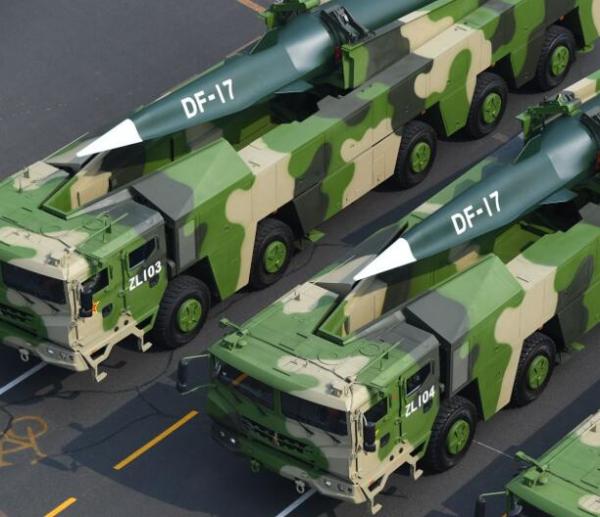 东风17很厉害了,但如果这是HCM,那就不只是“嘉手纳快递”,甚至不只是“关岛快递”,而是“夏威夷快递”、“洛杉矶快递“
东风17很厉害了,但如果这是HCM,那就不只是“嘉手纳快递”,甚至不只是“关岛快递”,而是“夏威夷快递”、“洛杉矶快递“
中国的具有军工意义的高技术研发具有保密传统,完整的带热管理的超燃冲压试验到底是进行了没有,成功与否,外界只有猜测。但在不远的一天又有哪个地方悄悄申报了一个创新奖,或者在哪一个重大庆典上猛然推出全新的HCM,人们也不必太惊讶。
在太平洋的另一边,美国在3月19日试验成功C-HGB,这是三军通用的HGV,但还在采用第一代的双锥体(也称旋成体),而不是东风17采用的更先进的乘波体。另一方面,美国负责国防科研的国防部副部长格里芬在谈到高超音速研究的时候,特别提到美国在热管理方面的缺门,使得本来射程达到3000公里的高超音速导弹的射程降低到1000公里。如果说中国离HCM还差临门一脚,美国则还没有过中场。高超音速是少有的中国占决定性领先地位的军工科技,这恰好也是对未来战争至关重要的核心军工科技。先进热管理技术进一步拉大了中国的领先距离。
点击进入专题:
新浪神评局20200605期
China's super-combustion stamping technology has achieved a breakthrough, far ahead of the United States
China's super-combustion stamping technology has achieved a breakthrough, far ahead of the United States
7,699
On May 30, SpaceX of the United States successfully launched the manned "Dragon" spacecraft. Nine years after the space shuttle grounded, the United States finally once again has the ability to launch manned space. This not only fulfilled Musk's dream, but also gave Trump a five-minute solution to the prison. But at the other end of the Pacific, the Institute of Mechanics of the Chinese Academy of Sciences quietly published a message that Fan Xuejun's team achieved a continuous running time of 600 seconds in the ground test of the scramjet engine, breaking the 210-second world of the US X-51 research machine. recording. In 2016, India announced that it achieved the M6 hypersonic flight propelled by scramjet, but the engine only operated for 5 seconds. Not long ago, in the second section of the National Innovation Competition Awards announced by the Ministry of Science and Technology, Beihang’s hypersonic strong pre-cooling team won the prize, which also aroused great concern. The significance of these two breakthrough technologies is not trivial.
In 2013, the US X-51A "Wanderer" set a world record of 210 seconds of continuous work at the speed of M5
Hypersonic speed is the forefront of aerospace technology. This is also a gray but colorful area between aviation in the atmosphere and space outside the atmosphere. Aerospace technology in the atmosphere is difficult to break through the thermal barrier of M3, and aerospace technology outside the atmosphere is difficult to solve the problem of high maneuverability. The hypersonic flight between the two can not only fly at high speeds of M5-20, but also has considerable maneuverability. .
At the 70th anniversary of the National Day in 2019, China displayed a high-profile Dongfeng 17 hypersonic missile, which represents the highest level of hypersonic speed, but this is still a hypersonic glide (HGV). In other words, after the missile propelled to near-earth altitude with a rocket engine, it changed its attitude and turned into hypersonic gliding. Compared with ballistic missiles, the flying height of HGV is low. Due to the curvature of the earth, the detection range of ground radar is much lower than that of ballistic missiles, and the cruising altitude of early warning aircraft cannot fundamentally solve the problem. The space-based detection in orbit has no theoretical horizon limitation, but traditional missile early warning is based on the huge tail flame and initial trajectory of the missile when launching to infer the trajectory. The HGV still has a tail flame problem during launch, but after turning into gliding It can completely get rid of simple trajectory through maneuverability, making the missile's trajectory unpredictable. It is theoretically possible to use satellite-based radar to track the entire range immediately after the launch is detected, but medium-orbit satellite tracking requires a huge satellite-borne radar, and low-orbit satellites require dense star clusters and "moving-to-moving" gapless relay tracking. Infrared photoelectric tracking not only has the similar optical aperture problem, but also faces the problem of detecting the weak HGV thermal characteristics in the complex thermal environment on the surface of the earth. In the foreseeable future, space-based exploration still has insurmountable technical difficulties. Without effective tracking, there is no effective interception, so HGV's penetration ability is faster than ballistic missiles that are faster but boring.
Comparison of detection distance between ballistic missile (RV) and hypersonic glide missile (HGV) Comparison of detection distance between ballistic missile (RV) and hypersonic glide missile (HGV)
Because of this, HGV has become the focus of military research in various countries. China not only has Dongfeng 17, but also Dongfeng 26, and also has the ability to glide at supersonic speeds. Russia's "pioneer" is the Intercontinental HGV, reaching the extremely high speed of M27. The United States has fallen behind, and after a lot of dazzling fast-track R&D plans, it is finally starting to get a bit cluttered. However, the range of the HGV depends on the height of the boost section or the leveling acceleration in the atmosphere. The former increases the difficulty of the smooth transition of Zha Mengzi back to horizontal skid, and the latter is to strongly twist the boost section of the essential trajectory. Now, energy is lost. At a higher level than HGV is a hypersonic cruise missile.
Cruise missiles are a term that can easily lead to ambiguity. This is actually a general term for all missiles that are powered at most distances within range. High-sonic cruise missiles that flew the ground are just one type of cruise missiles. Most tactical missiles are not called cruise missiles because the rocket engine only works for a short time, and the main part of the range is gliding. This is true not only for ballistic missiles, but also for air-to-air missiles, air-to-ground missiles and even anti-tank missiles. Among the common missiles, only anti-ship missiles and land-attack cruise missiles are fully powered. Hypersonic missiles use super-combustion ramjet engines, and are also full-powered flight, so they are called hypersonic cruise missiles (HCM for short).
Compared with HGV, HCM has a longer range and more difficult to detect trajectory. HGV's energy comes from booster-level rocket engines. Rocket engines with built-in oxidants always suffer from weight loss compared to jet engines that can draw oxygen from the air. Taking the kerosene-liquid oxygen rocket as an example, the ideal combustion air-fuel ratio is 15:1. In other words, each kilogram of aviation kerosene requires 15 kilograms of oxygen to be completely burned. Using liquid oxygen can save volume, but the weight is still the same. If the oxygen can come from the air, in theory, all the 15 kg of liquid oxygen weight can be transferred to kerosene, and the increase in range is self-evident.
Longer working time of the jet engine also means that there can be a longer acceleration time, can use the lower initial energy to reach the same maximum speed, and maintain a longer time at the maximum speed. The greater energy of the jet engine also means that greater mobility is allowed, because maneuvering consumes energy. Unlike HGV, which can only do relatively simple lateral maneuvers, HCM can do more complex maneuvers or even circuitous attacks.
The booster of HCM only needs to be accelerated to the ignition speed of the scramjet, so the requirements for the booster are greatly reduced, which helps reduce the volume and weight of the booster. A smaller booster means a smaller thermal signature at launch, while the thermal signature of the scramjet itself is much smaller than that of a rocket engine, which means that it is virtually impossible for HCM to be captured by space-based detection, further improving the resistance to early warning ability. Hypersonic missiles are inherently difficult to intercept, and intercepting without warning is almost impossible. If HGV is still likely to know that a big disaster is coming, HCM just knows how to die.
Compared to ballistic missiles, the trajectory of HGV is much more erratic. Compared to ballistic missiles, the trajectory of HGV is much more erratic.
However, HCM's trajectory is lower and more difficult to detect, and it can achieve higher range and maneuverability. But HCM's trajectory is lower and more difficult to detect, and it can also achieve higher range and maneuverability.
HCM is the ultimate hypersonic weapon. The United States once wanted to develop HCM directly in one step, but it was stuck on the issue of power. Although X-51 reaches 210 seconds, this is a highly optimized experimental condition, and the working time is too short, and there is still a huge distance from practical use. When the United States "released first", China quietly caught up and made breakthroughs in two key technologies at once.
In various known aerodynamic forces, the working time of the rocket engine is too short, it is difficult for the conventional turbojet engine to break the speed above M2.5, and the conventional sub-combustion stamping is also difficult to break through M4, because the increase in resistance is faster than The thrust has increased. Only scramjet can be used for HCM. This is also a ramjet engine, which belongs to the jet engine, but there is no turbo machinery of the conventional turbo jet engine. Supercombustion stamping is a hollow bobbin in appearance, but this hollow bobbin is very particular.
Compared with sub-combustion stamping, the intake compression, combustion and thrust generation of super-combustion stamping are all carried out under supersonic conditions. Compared with the sub-combustion stamping, the intake air is reduced to subsonic speed, and then the gas is accelerated to supersonic speed, which greatly reduces the resistance. However, under supersonic conditions, not only the combustion is difficult to stabilize, but also the problem of high temperature, it is easy to exceed the temperature limit of the structural material. The main contribution of Fan Xuejun's team lies in the active cooling technology of hot-end components.
Combustion-driven engines usually have some kind of cooling. Automobile engines are basically liquid-cooled. The circulating coolant removes heat from the engine, and then radiates the heat to the air through the radiator; the jet engine mainly relies on air flow and gas ejection to remove heat. However, active cooling spreads over the capillaries under the surface of the engine's hot end parts (for combustion stamping, the combustion chamber and the nozzle), which is fed with hydrocarbon fuel, which takes away heat in the flow and reduces the surface temperature. After the hydrocarbon fuel heats up, the actual temperature exceeds the ignition temperature, but due to the oxygen-free environment, it only heats up and does not burn. However, when hydrocarbon fuel is injected into the combustion chamber, on the one hand, it naturally depressurizes and gasifies, on the other hand, it mixes with the oxygen in the intake air and burns naturally, which is more efficient and reliable than ordinary ignition.
Hydrocarbon fuel is an advanced form of fuel oil, which can be easily converted into liquid hydrogen, with higher heat absorption and combustion efficiency. However, the preparation and storage of liquid hydrogen is more complicated than that of hydrocarbon fuel, and its stability at normal temperature and pressure is not as good as that of hydrocarbon fuel. The team of Fan Xuejun used hydrocarbon fuel with lower cost and better stability.
The principle of active cooling is not complicated, and the advantages are obvious, but the devil is in the details. The flow of hydrocarbon fuel in the capillary needs to consider the problem of fouling. The distribution of the capillary tube is more particular, too fine is not necessary, and too coarse to achieve the purpose. The bigger problem is that in the flow network, preferential flow makes the distribution of the flow deviate from the expected uniformity. In a bunch of pipelines that look similar, the flow of the "smooth" path may be higher than the demand, the path "not The flow rate may be insufficient, and the flow distribution must be balanced through the elaborate pipe diameter and elbow design to ensure uniform heat absorption. Intermediate interconnection between paths can be compensated by bypass flow when some paths are clogged, but the problem of dominant flow is further complicated. The flow in the capillary tube also needs to avoid the problem of gas resistance caused by fluid heating and vaporization.
Fan Xuejun's team not only solved a large number of theoretical and design problems, but also built a large test device in Huairou to solve engineering problems, making the research results reach a high degree of technical maturity.
According to the introduction of the Institute of Mechanics, Fan Xuejun obtained a postdoctoral fellow at Princeton, became a researcher and doctoral supervisor of the Institute of Mechanics, served as an expert in the transportation technology group of a certain ministry, an expert in the national major special fuel group and the chief of a major topic technology. He took the lead in developing active cooling engine technology research in China, and built the first set of active cooling technology comprehensive test platform at the Huairou base of the Institute of Mechanics, which is at the international advanced level in technology. He led the development of my country's first active cooling combustion chamber and passed the long-term test assessment. In recent years, it has published more than 50 domestic and foreign journal papers, more than 100 conference papers and national defense technical reports, more than 30 invention patent applications, and nearly 20 authorized applications. In 2006, won the second prize of National Defense Science and Technology; the leading technical research team won the 2011 National Excellent Special Research Team Award, and the individual won the second advanced individual award in 2013; at the same time won the first "ramjet engine and its combined cycle engine scientific research" "Xingzhou Award"; won the "Special Government Allowance" of the State Council in 2016; was hired as a special researcher of the Chinese Academy of Sciences in 2017. But this is not the only top team in China's hypersonic research army. Beihang's hypersonic strong pre-cooling team is another.
Active cooling technology improves the heat resistance of the hot end parts of the engine, and strong pre-cooling of the intake air can be further improved. Not long ago, the British SABRE engine achieved strong pre-cooling, which can cool the intake air of 1000 degrees to minus 150 degrees in 0.01 seconds. This is a remarkable achievement. The specific technology and application of the Beihang team have not been announced, but they are of the same nature.
Strong pre-cooling not only greatly improves the high temperature limit of the hot end parts of the engine, but also dramatically reduces the intake volume and improves the intake density. This makes the volumetric flow of the compressor greatly reduced under the same volumetric flow rate of the inlet; or the oxygen content of the airflow is greatly increased under the same volumetric flow of the compressor. The former can be equivalent to increasing the upper limit of the inlet flow rate, so that the same engine technology can work at higher speeds; the latter is particularly important for extremely high altitudes with thin air, which can make the jet engine stable at higher altitudes. Work, reduce the air friction resistance, otherwise you need to use a heavy weight, high cost, short working time rocket engine. SABRE is exactly that.
The working principle of SABRE, the pre-cooler like mosquito coils layered up layer by layer is the key technology. Orange = coolant flow direction, red = air inlet direction, blue = air outlet direction
Schematic diagram of SABRE thermodynamic cycle, blue=air route, purple=hydrogen route, green=helium circuit, red=gas route
The full name of SABRE is Synergetic Air Breathing Rocket Engine. This is a new concept hybrid engine for horizontal take-off, single-stage orbiting space shuttle. With strong pre-cooling, the working state of absorbing oxygen from the air can be maintained until M5 and ultra-high altitude, and then transferred to rocket power. Flying into space.
Specifically, after the air is strongly pre-cooled in the pre-cooler (PC), it reaches high pressure through the compressor (AC), and part of it enters the combustion chamber (CC), and is mixed with the hot, lean oxygen-rich hydrogen gas after pre-combustion. Thrust is generated through the nozzle (Nozzle); most of the air enters the pre-combustion chamber (PB), is mixed with hydrogen and burned, and heats the helium. After the helium gas is heated and expanded, a helium gas turbine (HeT) is driven to drive the compressor. After the work is cooled down, but still high temperature helium passes through the heat exchanger (HX4) to heat and vaporize the liquid hydrogen, forming a high pressure, driving the hydrogen turbine (HT1) to drive the liquid hydrogen pump (LHP) from the liquid hydrogen storage tank (LHT) Extract liquid hydrogen. The decompressed hydrogen still has enough pressure to continue to drive another hydrogen turbine (HT2) to drive the helium refrigeration compressor (HeC) for the pre-cooler, just like the Freon compressor in the refrigerator provides refrigerant . In fact, helium is equivalent to freon here.
The thermodynamic cycle of SABRE is quite complicated, but it is also very delicate. The original design of SABRE was not used for scramjet. The use of aspirated rocket engine just avoided the problem of scramjet. The hypersonic flight in the atmosphere is only a transitional stage, just to provide the highest possible power for rocket-powered flight outside the atmosphere. Starting speed and altitude. However, after appropriate simplification, SABRE's ideas can also be used for scramjet. For example, if the helium circuit is eliminated, the fuel from the fuel pump directly enters the precooler and the hot-end cooling system, which heats and gasifies to generate high pressure, and the driven turbine directly drives the fuel pump. In this way, even the pre-combustion chamber can be eliminated.
Both active cooling and strong pre-cooling are thermal management technologies for scramjet engines. People often focus on the combustion stability of scramjets. This is indeed a huge technical challenge, just as difficult as a controlled explosion, but thermal management is also a huge problem. At the landmark Xiamen International Conference in 2017, China hinted that the super-combustion stamping technology has reached a fairly high level of technical maturity. The thermal management technology has now reached a very high degree of technical maturity. What is not disclosed is the hypersonic flight test of a complete scramjet with advanced thermal management.
The significance of the practicality of scrambling stamping cannot be overemphasized. On the 70th National Day, only the appearance of Dongfeng 17 was disclosed, and there was no public range
中国超燃冲压技术获突破 已遥遥领先美国
中国超燃冲压技术获突破 已遥遥领先美国
7,699
5月30日,美国SpaceX公司成功发射了载人的“龙”飞船。在航天飞机停飞9年后,美国终于再次拥有了载人空间发射的能力。这不仅圆了马斯克的梦,也给身陷囹圄的特朗普解了5分钟的套。但是在太平洋的另一端,中国科学院力学研究所悄悄地发表了一条消息,范学军团队在超燃冲压发动机地面试验中实现了连续600秒的运行时间,打破了美国X-51研究机210秒的世界记录。2016年,印度宣布实现了超燃冲压推动的M6高超音速飞行,但发动机只工作了5秒钟。不久前,科技部公布的第二节全国创新争先奖名单里,北航的高超音速强预冷团队获奖,也引起了人们的极大关注。这两样突破性技术的意义非同小可。

高超音速是航空航天科技的最前沿。这也是介于大气层内的航空和大气层外的航天之间的灰色但多彩的区域。大气层内的航空科技难以突破M3的热障,大气层外的航天科技难以解决高机动飞行问题,介于两者之间的高超音速飞行不仅可以M5-20的超高速飞行,还具有可观的机动能力。
在2019年国庆70周年大庆的时候,中国高调展示了东风17高超音速导弹,这代表了当前高超音速的最高水平,但这还是高超音速滑翔弹(简称HGV)。换句话说,导弹用火箭发动机推进到近地高度后,改变姿态,转入高超音速滑翔。与弹道导弹相比,HGV的飞行高度低,由于地球曲率的缘故,地面雷达的探测距离远远低于弹道导弹,预警机的巡航高度也不能根本解决问题。在轨道上的天基探测在理论上没有视界局限,但传统导弹预警是根据导弹发射时的巨大尾焰和初始轨迹来推断弹道的,HGV在发射时依然有尾焰问题,但转入滑翔后,可以通过机动能力完全摆脱简单弹道,使得导弹的航迹无法预测。在探测到发射后立刻用星载雷达全程跟踪在理论上是可能的,但中轨道卫星跟踪需要巨大的星载雷达,低轨道卫星则需要密集星群和“动对动”无间隙接力跟踪。红外光电跟踪不仅有类似的光学孔径问题,还要面对复杂的地球表面热环境中检测微弱的HGV热特征的问题。在可预见的将来,天基探测还有难以克服的技术困难。没有有效的跟踪,就谈不上有效的拦截,所以HGV的突防能力比速度更快但弹道呆板的弹道导弹更高。

正因为如此,HGV成为各国军事科研的重点。中国不仅有东风17,还有东风26,也具有高超音速滑翔的能力。俄罗斯的“先锋”是洲际HGV,达到M27的极高速。美国落后了,在一大堆令人眼花缭乱的快车道研发计划之后,现在总算开始有点头绪了。但HGV的射程取决于助推段达到的高度或者大气层内的改平加速,前者增加了扎猛子返回到水平起滑的平滑过渡的难度,后者是把本质弹道的助推段强拧变轨了,损失能量。比HGV更高层次的是高超音速巡航导弹。
巡航导弹是一个容易引起歧义的称呼,这其实是对所有在射程内绝大部分距离上都是有动力飞行的导弹的总称,掠地飞行的高亚音速巡航导弹只是巡航导弹的一种。大部分战术导弹不称为巡航导弹是因为火箭发动机只工作很短时间,射程内主要部份都在滑翔飞行。这不仅对弹道导弹如此,空空导弹、空地导弹甚至反坦克导弹也如此。常见导弹中只有反舰导弹、陆攻巡航导弹是全程有动力飞行的。高超音速导弹采用超燃冲压发动机后,也是全程有动力飞行,所以称为高超音速巡航导弹(简称HCM)。
与HGV相比,HCM的射程更大,弹道更难探测。HGV的能量全部来自于助推级的火箭发动机。自带氧化剂的火箭发动机在重量上比可以从空气中吸取氧气的喷气发动机总是吃亏的。以煤油-液氧火箭为例,理想燃烧的空燃比为15:1。也就是说,每一公斤航空煤油需要15公斤氧气才能完全燃烧。用液氧可以节约体积,但重量还是一样的。如果氧气可以来自空气,在理论上,这15公斤的液氧重量就全部可以转用于煤油,射程的增加不言而喻。
喷气发动机更长的工作时间也意味着可以有更长的加速时间,可以用较低的初始能量达到同样的最高速度,并在最高速度上维持更长的时间。喷气发动机更大的能量也意味着容许更大的机动性,因为机动是要消耗能量的。与HGV只能做相对简单的横向机动不同,HCM可以做更加复杂的机动,甚至迂回攻击。
HCM的助推器只要加速到超燃冲压的点火速度就可以了,因此对助推器的要求大大降低,有助于降低助推器的体积和重量。较小的助推器意味着较小的发射时热特征,而超燃冲压本身的热特征远远小于火箭发动机,这意味着HCM实际上不可能由天基探测捕获,进一步提高抗早期预警的能力。高超音速导弹本来就拦截困难,无预警拦截就几乎不可能了。如果说HGV还有可能知道大祸即将临头,HCM就是死都不知道怎么死的了。


HCM是终极高超音速武器。美国曾经想一步到位,直接发展HCM,但卡在动力问题上。X-51虽然达到210秒,但这是高度优化的实验条件,而且工作时间太短,离实用化还有巨大的距离。在美国“先放一放”的时候,中国悄悄赶上来了,而且一下子在两个关键技术上取得突破。
在各种已知的航空动力中,火箭发动机的工作时间太短,常规涡轮类喷气发动机难以突破M2.5以上的速度,常规的亚燃冲压也很难突破M4,因为阻力的增加已经快于推力的增加了。只有超燃冲压能用于HCM。这也是冲压发动机,属于喷气发动机,但没有常规涡轮类喷气发动机的涡轮机械。超燃冲压在外观上就是一截空心筒子,但这空心筒子大有讲究。
与亚燃冲压相比,超燃冲压的进气压缩、燃烧和形成推力都是在超音速条件下进行的。与亚燃冲压需要把进气降低到亚音速、然后把燃气加速到超音速相比,大大降低了阻力。但在超音速条件下,不仅燃烧难以稳定,还有高温问题,很容易超过结构材料的耐温极限。范学军团队的主要贡献在于热端部件主动冷却技术。
以燃烧为原动力的发动机通常都有某种冷却。汽车发动机基本上采用液冷,循环的冷却液从发动机带走热量,然后把热量通过散热器向空气中散发;喷气发动机主要依靠空气流动和燃气喷出带走热量。但主动冷却在发动机热端部件(对超燃冲压来说,就是燃烧室和喷嘴)表面下遍布毛细管,通入碳氢燃料,在流动中带走热量,降低表面温度。碳氢燃料吸热升温后,实际温度超过点燃温度,但由于无氧环境而只是升温,并不燃烧。但碳氢燃料注入燃烧室的时候,一方面自然地降压气化,另一方面与进气中的氧混合并自然燃烧,比通常的点燃更加高效可靠。
碳氢燃料是燃油的高级形式,进一步的话可容易地转变为液氢,吸热和燃烧效率更高。但液氢的制备和储存比碳氢燃料要复杂,常温常压下的稳定性也不如碳氢燃料。范学军团队用的是成本更低、稳定性更好的碳氢燃料。
主动冷却的道理不复杂,优点也明显,但恶魔就在细节之中。碳氢燃料在毛细管里的流动需要考虑淤塞问题。毛细管的分布更是有大讲究,过于细密没有必要,过于粗疏则达不到目的。更大的问题是,在流动网络里,优势流动(preferential flow)使得流动的分布偏离预想的均匀,一束看起来差不多的管路里,路径“顺”的流量可能高于需求,路径“不顺”的则可能流量不足,必须通过精细的管径、弯头设计来平衡流量分布,确保均匀吸热。路径之间中途互联可以在部份路径淤塞的时候,用绕流弥补,但使得优势流动的问题进一步复杂化。毛细管内的流动还需要避免流体加热气化后导致气阻的问题。
范学军团队不仅解决了大量理论和设计问题,还在怀柔建造了大型测试装置,解决了工程问题,使得研究成果达到很高的技术成熟程度。
根据力学所的介绍,范学军在普林斯顿获得博士后,成为力学所研究员、博导,担任某部委运载技术专业组专家、国家重大专项燃料组专家与某重大专题技术首席。他在国内率先开展主动冷却发动机技术研究,在力学所怀柔基地建成首套主动冷却技术综合试验平台,技术上处于国际领先水平。他领导研制成功了我国首台主动冷却燃烧室并通过长时间试验考核。近年来,共发表国内外杂志论文50多篇、会议论文与国防技术报告100多篇,发明专利申请30多项、已授权近20项。2006年,荣获国防科技二等奖;领导的技术研究团队荣获了国家重大专项2011年度优秀研究团队奖,个人获得2013年度先进个人二等奖;同时获得首届“冲压发动机及其组合循环发动机科学研究兴舟奖”;2016年获得国务院“政府特殊津贴”;2017年被聘为中科院特聘研究员。但这不是中国高超音速科研大军里唯一的尖子队,北航的高超音速强预冷团队是另一个。
主动冷却技术提高发动机热端部件的耐热能力,进气强预冷可以进一步提高。不久前,英国的SABRE发动机实现了强预冷,可在0.01秒内将1000度的进气冷却到零下150度。这是很了不起的成就。北航团队的具体技术和应用没有公布,但也是同样性质的。
强预冷不仅大幅度提高发动机热端部件的耐高温极限,还急剧缩小了进气体积,提高了进气密度。这使得在同样的进气口体积流量下,压气机的体积流量大幅度降低;或者在同样的压气机体积流量下,大幅度提高气流中的氧含量。前者可以等效为提高了进气口流速的上限,使得同样的发动机技术可以在更高的速度下工作;后者对空气稀薄的极高空特别重要,可以使得喷气发动机可以在更高的高空稳定工作,降低空气摩擦阻力,否则就需要使用重量大、成本高、工作时间短的火箭发动机了。SABRE正是这样的。


SABRE的全称是Synergetic Air Breathing Rocket Engine,大意为伴生吸气火箭发动机。这是一种用于水平起飞、单级入轨航天飞机的新概念混合动力发动机,用强预冷使得从空气中吸取氧的工作状态可以一直维持到M5和超高空,然后转入火箭动力,进入空间飞行。
具体来说,进气在预冷器(PC)里强预冷后,通过压气机(AC)达到高压,一部分进入燃烧室(CC),与预燃后炽热的贫氧富氢燃气混合燃烧,通过喷嘴(Nozzle)产生推力;大部分空气进入预燃室(PB),与氢气混合燃烧后,加热氦气。氦气受热膨胀后,推动氦气涡轮(HeT)驱动压气机。做功降温后但依然有很高温度的氦气通过换热器(HX4)使得液氢受热气化,形成高压,推动氢气涡轮(HT1)驱动液氢泵(LHP)从液氢储罐(LHT)里抽取液氢。降压后的氢气还有足够压力,继续推动另一台氢气涡轮(HT2),驱动氦气制冷压缩机(HeC),用于预冷器,就像电冰箱里的氟利昂压缩机提供制冷剂一样。事实上,氦在这里就相当于氟利昂。
SABRE的热力学循环相当复杂,但也很精巧。SABRE的设计原意不是用于超燃冲压的,使用吸气火箭发动机正好回避了超燃冲压的难题,大气层内的高超音速飞行也只是过渡阶段,只是为大气层外的火箭动力飞行提供尽可能高的起始速度和高度。但是适当简化后,SABRE的思路也可以用于超燃冲压。比如说,取消氦回路,燃料泵出来的燃料直接进入预冷器和热端冷却系统,加热气化产生高压,推动的涡轮直接驱动燃料泵。这样,连预燃室都可以取消了。
主动冷却和强预冷都属于超燃冲压发动机的热管理技术。人们经常关注于超燃冲压的燃烧稳定性问题,这确实是巨大的技术挑战,就像可控爆炸一样艰难,但热管理是同样巨大的难题。中国在2017年里程碑式的厦门国际会议上,就暗示了超燃冲压技术已经达到相当高的技术成熟程度。现在热管理技术也达到了很高的技术成熟程度,没有公开的只是带先进热管理的完整的超燃冲压发动机的高超音速飞行试验。
超燃冲压实用化的意义是怎么强调也不过份的。国庆70大庆上只公开了东风17的外观,射程没有公布,据估计,在1800-2500公里范围。采用超燃冲压、从HGV改为HCM的话,只需要较小的助推火箭就可以起飞,大量氧化剂占用的重量可转为燃料,极大地增加射程。即使计入更重的超燃冲压发动机和辅助系统,射程的增加也是可想而知的。即使不可能增加15倍的射程,而只能增加5倍,也能在大体相同的全系统尺寸和重量情况下,达到9000-12500公里的射程。如果说东风17还只是“嘉手纳快递”的话,“超级东风17”就不只是关岛快递了,而是“夏威夷快递”、“洛杉矶快递”了,军事意义不言而喻。

中国的具有军工意义的高技术研发具有保密传统,完整的带热管理的超燃冲压试验到底是进行了没有,成功与否,外界只有猜测。但在不远的一天又有哪个地方悄悄申报了一个创新奖,或者在哪一个重大庆典上猛然推出全新的HCM,人们也不必太惊讶。
在太平洋的另一边,美国在3月19日试验成功C-HGB,这是三军通用的HGV,但还在采用第一代的双锥体(也称旋成体),而不是东风17采用的更先进的乘波体。另一方面,美国负责国防科研的国防部副部长格里芬在谈到高超音速研究的时候,特别提到美国在热管理方面的缺门,使得本来射程达到3000公里的高超音速导弹的射程降低到1000公里。如果说中国离HCM还差临门一脚,美国则还没有过中场。高超音速是少有的中国占决定性领先地位的军工科技,这恰好也是对未来战争至关重要的核心军工科技。先进热管理技术进一步拉大了中国的领先距离。
点击进入专题:
新浪神评局20200605期
China's super-combustion stamping technology has achieved a breakthrough, far ahead of the United States
China's super-combustion stamping technology has achieved a breakthrough, far ahead of the United States
7,699
On May 30, SpaceX of the United States successfully launched the manned "Dragon" spacecraft. Nine years after the space shuttle grounded, the United States finally once again has the ability to launch manned space. This not only fulfilled Musk's dream, but also gave Trump a five-minute solution to the prison. But at the other end of the Pacific, the Institute of Mechanics of the Chinese Academy of Sciences quietly published a message that Fan Xuejun's team achieved a continuous running time of 600 seconds in the ground test of the scramjet engine, breaking the 210-second world of the US X-51 research machine. recording. In 2016, India announced that it achieved the M6 hypersonic flight propelled by scramjet, but the engine only operated for 5 seconds. Not long ago, in the second section of the National Innovation Competition Awards announced by the Ministry of Science and Technology, Beihang’s hypersonic strong pre-cooling team won the prize, which also aroused great concern. The significance of these two breakthrough technologies is not trivial.
In 2013, the US X-51A "Wanderer" set a world record of 210 seconds of continuous work at the speed of M5
Hypersonic speed is the forefront of aerospace technology. This is also a gray but colorful area between aviation in the atmosphere and space outside the atmosphere. Aerospace technology in the atmosphere is difficult to break through the thermal barrier of M3, and aerospace technology outside the atmosphere is difficult to solve the problem of high maneuverability. The hypersonic flight between the two can not only fly at high speeds of M5-20, but also has considerable maneuverability. .
At the 70th anniversary of the National Day in 2019, China displayed a high-profile Dongfeng 17 hypersonic missile, which represents the highest level of hypersonic speed, but this is still a hypersonic glide (HGV). In other words, after the missile propelled to near-earth altitude with a rocket engine, it changed its attitude and turned into hypersonic gliding. Compared with ballistic missiles, the flying height of HGV is low. Due to the curvature of the earth, the detection range of ground radar is much lower than that of ballistic missiles, and the cruising altitude of early warning aircraft cannot fundamentally solve the problem. The space-based detection in orbit has no theoretical horizon limitation, but traditional missile early warning is based on the huge tail flame and initial trajectory of the missile when launching to infer the trajectory. The HGV still has a tail flame problem during launch, but after turning into gliding It can completely get rid of simple trajectory through maneuverability, making the missile's trajectory unpredictable. It is theoretically possible to use satellite-based radar to track the entire range immediately after the launch is detected, but medium-orbit satellite tracking requires a huge satellite-borne radar, and low-orbit satellites require dense star clusters and "moving-to-moving" gapless relay tracking. Infrared photoelectric tracking not only has the similar optical aperture problem, but also faces the problem of detecting the weak HGV thermal characteristics in the complex thermal environment on the surface of the earth. In the foreseeable future, space-based exploration still has insurmountable technical difficulties. Without effective tracking, there is no effective interception, so HGV's penetration ability is faster than ballistic missiles that are faster but boring.
Comparison of detection distance between ballistic missile (RV) and hypersonic glide missile (HGV) Comparison of detection distance between ballistic missile (RV) and hypersonic glide missile (HGV)
Because of this, HGV has become the focus of military research in various countries. China not only has Dongfeng 17, but also Dongfeng 26, and also has the ability to glide at supersonic speeds. Russia's "pioneer" is the Intercontinental HGV, reaching the extremely high speed of M27. The United States has fallen behind, and after a lot of dazzling fast-track R&D plans, it is finally starting to get a bit cluttered. However, the range of the HGV depends on the height of the boost section or the leveling acceleration in the atmosphere. The former increases the difficulty of the smooth transition of Zha Mengzi back to horizontal skid, and the latter is to strongly twist the boost section of the essential trajectory. Now, energy is lost. At a higher level than HGV is a hypersonic cruise missile.
Cruise missiles are a term that can easily lead to ambiguity. This is actually a general term for all missiles that are powered at most distances within range. High-sonic cruise missiles that flew the ground are just one type of cruise missiles. Most tactical missiles are not called cruise missiles because the rocket engine only works for a short time, and the main part of the range is gliding. This is true not only for ballistic missiles, but also for air-to-air missiles, air-to-ground missiles and even anti-tank missiles. Among the common missiles, only anti-ship missiles and land-attack cruise missiles are fully powered. Hypersonic missiles use super-combustion ramjet engines, and are also full-powered flight, so they are called hypersonic cruise missiles (HCM for short).
Compared with HGV, HCM has a longer range and more difficult to detect trajectory. HGV's energy comes from booster-level rocket engines. Rocket engines with built-in oxidants always suffer from weight loss compared to jet engines that can draw oxygen from the air. Taking the kerosene-liquid oxygen rocket as an example, the ideal combustion air-fuel ratio is 15:1. In other words, each kilogram of aviation kerosene requires 15 kilograms of oxygen to be completely burned. Using liquid oxygen can save volume, but the weight is still the same. If the oxygen can come from the air, in theory, all the 15 kg of liquid oxygen weight can be transferred to kerosene, and the increase in range is self-evident.
Longer working time of the jet engine also means that there can be a longer acceleration time, can use the lower initial energy to reach the same maximum speed, and maintain a longer time at the maximum speed. The greater energy of the jet engine also means that greater mobility is allowed, because maneuvering consumes energy. Unlike HGV, which can only do relatively simple lateral maneuvers, HCM can do more complex maneuvers or even circuitous attacks.
The booster of HCM only needs to be accelerated to the ignition speed of the scramjet, so the requirements for the booster are greatly reduced, which helps reduce the volume and weight of the booster. A smaller booster means a smaller thermal signature at launch, while the thermal signature of the scramjet itself is much smaller than that of a rocket engine, which means that it is virtually impossible for HCM to be captured by space-based detection, further improving the resistance to early warning ability. Hypersonic missiles are inherently difficult to intercept, and intercepting without warning is almost impossible. If HGV is still likely to know that a big disaster is coming, HCM just knows how to die.
Compared to ballistic missiles, the trajectory of HGV is much more erratic. Compared to ballistic missiles, the trajectory of HGV is much more erratic.
However, HCM's trajectory is lower and more difficult to detect, and it can achieve higher range and maneuverability. But HCM's trajectory is lower and more difficult to detect, and it can also achieve higher range and maneuverability.
HCM is the ultimate hypersonic weapon. The United States once wanted to develop HCM directly in one step, but it was stuck on the issue of power. Although X-51 reaches 210 seconds, this is a highly optimized experimental condition, and the working time is too short, and there is still a huge distance from practical use. When the United States "released first", China quietly caught up and made breakthroughs in two key technologies at once.
In various known aerodynamic forces, the working time of the rocket engine is too short, it is difficult for the conventional turbojet engine to break the speed above M2.5, and the conventional sub-combustion stamping is also difficult to break through M4, because the increase in resistance is faster than The thrust has increased. Only scramjet can be used for HCM. This is also a ramjet engine, which belongs to the jet engine, but there is no turbo machinery of the conventional turbo jet engine. Supercombustion stamping is a hollow bobbin in appearance, but this hollow bobbin is very particular.
Compared with sub-combustion stamping, the intake compression, combustion and thrust generation of super-combustion stamping are all carried out under supersonic conditions. Compared with the sub-combustion stamping, the intake air is reduced to subsonic speed, and then the gas is accelerated to supersonic speed, which greatly reduces the resistance. However, under supersonic conditions, not only the combustion is difficult to stabilize, but also the problem of high temperature, it is easy to exceed the temperature limit of the structural material. The main contribution of Fan Xuejun's team lies in the active cooling technology of hot-end components.
Combustion-driven engines usually have some kind of cooling. Automobile engines are basically liquid-cooled. The circulating coolant removes heat from the engine, and then radiates the heat to the air through the radiator; the jet engine mainly relies on air flow and gas ejection to remove heat. However, active cooling spreads over the capillaries under the surface of the engine's hot end parts (for combustion stamping, the combustion chamber and the nozzle), which is fed with hydrocarbon fuel, which takes away heat in the flow and reduces the surface temperature. After the hydrocarbon fuel heats up, the actual temperature exceeds the ignition temperature, but due to the oxygen-free environment, it only heats up and does not burn. However, when hydrocarbon fuel is injected into the combustion chamber, on the one hand, it naturally depressurizes and gasifies, on the other hand, it mixes with the oxygen in the intake air and burns naturally, which is more efficient and reliable than ordinary ignition.
Hydrocarbon fuel is an advanced form of fuel oil, which can be easily converted into liquid hydrogen, with higher heat absorption and combustion efficiency. However, the preparation and storage of liquid hydrogen is more complicated than that of hydrocarbon fuel, and its stability at normal temperature and pressure is not as good as that of hydrocarbon fuel. The team of Fan Xuejun used hydrocarbon fuel with lower cost and better stability.
The principle of active cooling is not complicated, and the advantages are obvious, but the devil is in the details. The flow of hydrocarbon fuel in the capillary needs to consider the problem of fouling. The distribution of the capillary tube is more particular, too fine is not necessary, and too coarse to achieve the purpose. The bigger problem is that in the flow network, preferential flow makes the distribution of the flow deviate from the expected uniformity. In a bunch of pipelines that look similar, the flow of the "smooth" path may be higher than the demand, the path "not The flow rate may be insufficient, and the flow distribution must be balanced through the elaborate pipe diameter and elbow design to ensure uniform heat absorption. Intermediate interconnection between paths can be compensated by bypass flow when some paths are clogged, but the problem of dominant flow is further complicated. The flow in the capillary tube also needs to avoid the problem of gas resistance caused by fluid heating and vaporization.
Fan Xuejun's team not only solved a large number of theoretical and design problems, but also built a large test device in Huairou to solve engineering problems, making the research results reach a high degree of technical maturity.
According to the introduction of the Institute of Mechanics, Fan Xuejun obtained a postdoctoral fellow at Princeton, became a researcher and doctoral supervisor of the Institute of Mechanics, served as an expert in the transportation technology group of a certain ministry, an expert in the national major special fuel group and the chief of a major topic technology. He took the lead in developing active cooling engine technology research in China, and built the first set of active cooling technology comprehensive test platform at the Huairou base of the Institute of Mechanics, which is at the international advanced level in technology. He led the development of my country's first active cooling combustion chamber and passed the long-term test assessment. In recent years, it has published more than 50 domestic and foreign journal papers, more than 100 conference papers and national defense technical reports, more than 30 invention patent applications, and nearly 20 authorized applications. In 2006, won the second prize of National Defense Science and Technology; the leading technical research team won the 2011 National Excellent Special Research Team Award, and the individual won the second advanced individual award in 2013; at the same time won the first "ramjet engine and its combined cycle engine scientific research" "Xingzhou Award"; won the "Special Government Allowance" of the State Council in 2016; was hired as a special researcher of the Chinese Academy of Sciences in 2017. But this is not the only top team in China's hypersonic research army. Beihang's hypersonic strong pre-cooling team is another.
Active cooling technology improves the heat resistance of the hot end parts of the engine, and strong pre-cooling of the intake air can be further improved. Not long ago, the British SABRE engine achieved strong pre-cooling, which can cool the intake air of 1000 degrees to minus 150 degrees in 0.01 seconds. This is a remarkable achievement. The specific technology and application of the Beihang team have not been announced, but they are of the same nature.
Strong pre-cooling not only greatly improves the high temperature limit of the hot end parts of the engine, but also dramatically reduces the intake volume and improves the intake density. This makes the volumetric flow of the compressor greatly reduced under the same volumetric flow rate of the inlet; or the oxygen content of the airflow is greatly increased under the same volumetric flow of the compressor. The former can be equivalent to increasing the upper limit of the inlet flow rate, so that the same engine technology can work at higher speeds; the latter is particularly important for extremely high altitudes with thin air, which can make the jet engine stable at higher altitudes. Work, reduce the air friction resistance, otherwise you need to use a heavy weight, high cost, short working time rocket engine. SABRE is exactly that.
The working principle of SABRE, the pre-cooler like mosquito coils layered up layer by layer is the key technology. Orange = coolant flow direction, red = air inlet direction, blue = air outlet direction
Schematic diagram of SABRE thermodynamic cycle, blue=air route, purple=hydrogen route, green=helium circuit, red=gas route
The full name of SABRE is Synergetic Air Breathing Rocket Engine. This is a new concept hybrid engine for horizontal take-off, single-stage orbiting space shuttle. With strong pre-cooling, the working state of absorbing oxygen from the air can be maintained until M5 and ultra-high altitude, and then transferred to rocket power. Flying into space.
Specifically, after the air is strongly pre-cooled in the pre-cooler (PC), it reaches high pressure through the compressor (AC), and part of it enters the combustion chamber (CC), and is mixed with the hot, lean oxygen-rich hydrogen gas after pre-combustion. Thrust is generated through the nozzle (Nozzle); most of the air enters the pre-combustion chamber (PB), is mixed with hydrogen and burned, and heats the helium. After the helium gas is heated and expanded, a helium gas turbine (HeT) is driven to drive the compressor. After the work is cooled down, but still high temperature helium passes through the heat exchanger (HX4) to heat and vaporize the liquid hydrogen, forming a high pressure, driving the hydrogen turbine (HT1) to drive the liquid hydrogen pump (LHP) from the liquid hydrogen storage tank (LHT) Extract liquid hydrogen. The decompressed hydrogen still has enough pressure to continue to drive another hydrogen turbine (HT2) to drive the helium refrigeration compressor (HeC) for the pre-cooler, just like the Freon compressor in the refrigerator provides refrigerant . In fact, helium is equivalent to freon here.
The thermodynamic cycle of SABRE is quite complicated, but it is also very delicate. The original design of SABRE was not used for scramjet. The use of aspirated rocket engine just avoided the problem of scramjet. The hypersonic flight in the atmosphere is only a transitional stage, just to provide the highest possible power for rocket-powered flight outside the atmosphere. Starting speed and altitude. However, after appropriate simplification, SABRE's ideas can also be used for scramjet. For example, if the helium circuit is eliminated, the fuel from the fuel pump directly enters the precooler and the hot-end cooling system, which heats and gasifies to generate high pressure, and the driven turbine directly drives the fuel pump. In this way, even the pre-combustion chamber can be eliminated.
Both active cooling and strong pre-cooling are thermal management technologies for scramjet engines. People often focus on the combustion stability of scramjets. This is indeed a huge technical challenge, just as difficult as a controlled explosion, but thermal management is also a huge problem. At the landmark Xiamen International Conference in 2017, China hinted that the super-combustion stamping technology has reached a fairly high level of technical maturity. The thermal management technology has now reached a very high degree of technical maturity. What is not disclosed is the hypersonic flight test of a complete scramjet with advanced thermal management.
The significance of the practicality of scrambling stamping cannot be overemphasized. On the 70th National Day, only the appearance of Dongfeng 17 was disclosed, and there was no public range

